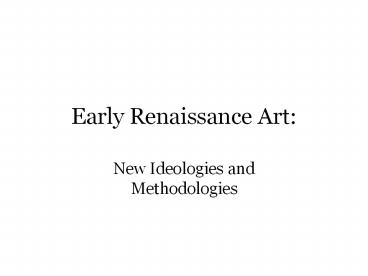Early Renaissance Art: - PowerPoint PPT Presentation
Title:
Early Renaissance Art:
Description:
Cimabue, Madonna in Majesty, 1285. Giotto, Madonna Enthroned, 1305. Giotto, Madonna Enthroned, 1305. Masaccio, Madonna Enthroned, 1426. Filippo Brunelleschi ... – PowerPoint PPT presentation
Number of Views:149
Avg rating:3.0/5.0
Title: Early Renaissance Art:
1
Early Renaissance Art
- New Ideologies and Methodologies
2
1st Generation
- MASACCIO
- (painting)
- BRUNELLESCHI
- (architecture)
- DONATELLO (sculpture)
3
- Shared characteristics
- faith in the theoretical foundations of art
- conviction that development and progress were not
only possible but essential to the arts - reverence for Ancient art but not merely to
imitate it - search to create art forms consistent with the
appearance of the natural world and with their
experience of human personality and behavior - efforts to discover the correct laws of
proportion for architecture and for the
representation of the human body and to
systematize the rendering of pictorial space - rendering of ideal forms rather than literal
appearance - concept of the physical world as the vehicle or
imperfect embodiment of monumental spiritual
beauty
4
The Development of Perspective
5
Cimabue, Madonna in Majesty, 1285
Giotto, Madonna Enthroned, 1305
6
Masaccio, Madonna Enthroned, 1426
Giotto, Madonna Enthroned, 1305
7
Filippo Brunelleschi Perspective
- In 1415, Brunelleschi painted his picture of the
Baptistry on the surface of a small mirror, right
on top of its own reflection. - To demonstrate the fact that his painting was
indeed an exact replica that could fool the eye,
Brunelleschi drilled a small hole in the mirror
and then stood directly in front of the
Baptistry, looking through the peephole to see
the real building. - He then held up a second, clean mirror in front
of his painted panel. The second mirror blocked
the view of the real building, but now reflected
his painted version on the original mirror. - By moving the second mirror in and out of the
way, Brunelleschi could check whether his
painting was indeed an exact copy of the
three-dimensional, octagonal building on the
two-dimensional surface of his original mirror.
8
(No Transcript)
9
Masaccio, The Holy Trinity, 1426
10
Beyond Perspective Basic Notions
- Proportion
- Linear Perspective
- Chiaroscuro
- Contrapposto
- These ideas were
- By the late 15th century, generally accepted
- Not merely the imperfect but necessary
preparation for the perfection of High
Renaissance art but a period of great intrinsic
merit - In retrospect, however, Early Renaissance
painting seems to fall short of thoroughly
convincing figural representation, and its
expression of human emotion is stylized rather
than real. - Furthermore, the strength of individual features
of a work of art is disproportionate to the whole
composition.
11
Beyond Perspective Basic Notions
- Proportion
- A scientific measure of ratios
- Particularly important in architecture
- Based on human proportions
12
Beyond Perspective Basic Notions
- Linear Perspective
13
Beyond Perspective Basic Notions
- Chiaroscuro
- discovered by Masaccio
- referred to the new technique for modeling forms
in painting by which lighter parts seemed to
emerge from darker areas, producing the illusion
of rounded, sculptural relief on a flat surface.
14
(No Transcript)
15
Beyond Perspective Basic Notions
- Contrapposto
16
The Renaissance Affinity for the Individual
Sandro Boticelli, Giuliano de Medici, c. 1478
Sandro Boticelli, Simonetta Vespucci, c. 1478
17
Ghirlandaio, Old Man and His Grandson, c. 1490
Piero della Francesca, Federico da Montefeltro,
c. 1465
18
Early Renaissance Architecture
19
Humanistic Ideals in Architecture
Filippo Brunelleschi, Ospedale degli Innocenti,
1421-24
20
Filippo Brunelleschi, Santo Spiritu
(Mantua) 1436-1482
21
Leonardo da Vinci, Ideal Church
22
Early Renaissance Sculpture
23
Donatello (ca 1386-1466)































